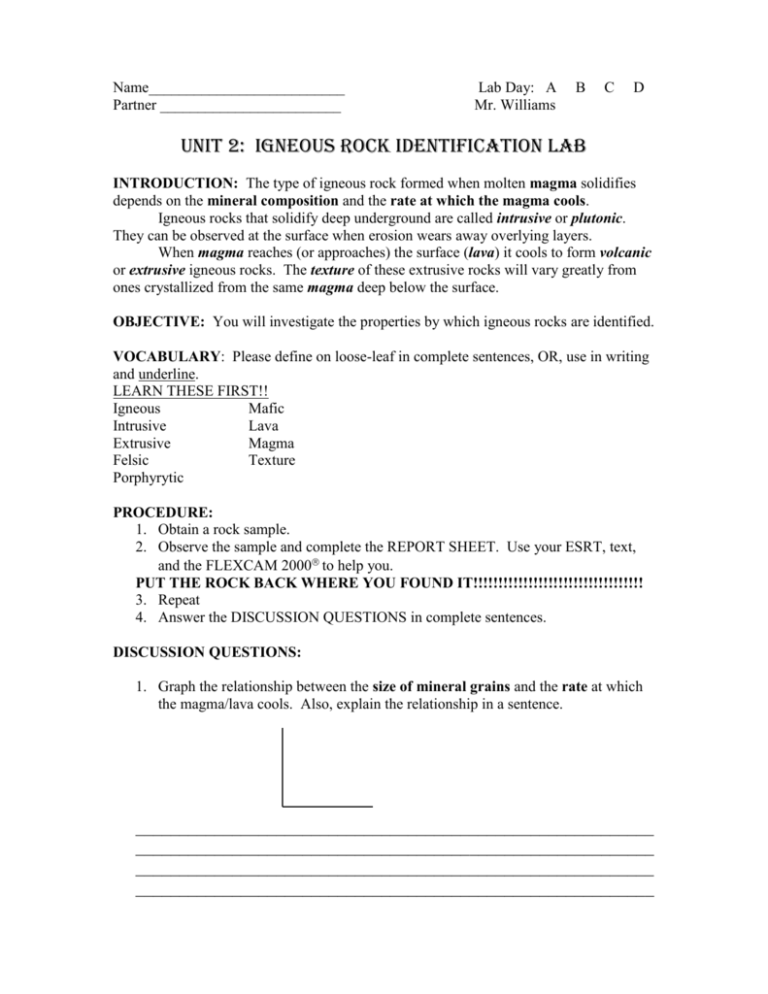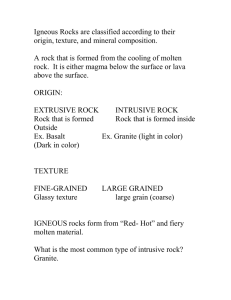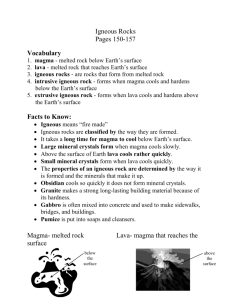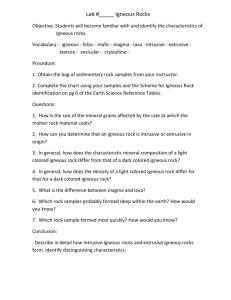unit 2: igneous rock identification lab
advertisement

Name__________________________ Partner ________________________ Lab Day: A Mr. Williams B C D UNIT 2: IGNEOUS ROCK IDENTIFICATION LAB INTRODUCTION: The type of igneous rock formed when molten magma solidifies depends on the mineral composition and the rate at which the magma cools. Igneous rocks that solidify deep underground are called intrusive or plutonic. They can be observed at the surface when erosion wears away overlying layers. When magma reaches (or approaches) the surface (lava) it cools to form volcanic or extrusive igneous rocks. The texture of these extrusive rocks will vary greatly from ones crystallized from the same magma deep below the surface. OBJECTIVE: You will investigate the properties by which igneous rocks are identified. VOCABULARY: Please define on loose-leaf in complete sentences, OR, use in writing and underline. LEARN THESE FIRST!! Igneous Mafic Intrusive Lava Extrusive Magma Felsic Texture Porphyrytic PROCEDURE: 1. Obtain a rock sample. 2. Observe the sample and complete the REPORT SHEET. Use your ESRT, text, and the FLEXCAM 2000 to help you. PUT THE ROCK BACK WHERE YOU FOUND IT!!!!!!!!!!!!!!!!!!!!!!!!!!!!!!!!!! 3. Repeat 4. Answer the DISCUSSION QUESTIONS in complete sentences. DISCUSSION QUESTIONS: 1. Graph the relationship between the size of mineral grains and the rate at which the magma/lava cools. Also, explain the relationship in a sentence. ___________________________________________________________ ___________________________________________________________ ___________________________________________________________ ___________________________________________________________ 2. How can you determine if an igneous rock has had an intrusive or extrusive origin? Please be specific. Example of an unspecific answer: “It depends on the texture.” ___________________________________________________________ ___________________________________________________________ ___________________________________________________________ ___________________________________________________________ 3. In general, how does the mineral composition of a light colored igneous rock differ from that of a dark colored igneous rock? Be specific, and give example(s). _____________________________________________________________________ _____________________________________________________________________ _____________________________________________________________________ _____________________________________________________________________ _____________________________________________________________________ _____________________________________________________________________ _____________________________________________________________________ 4. In general, how does the density of a light colored igneous rock differ from that of a dark colored igneous rock? Be specific and give example(s). _____________________________________________________________________ _____________________________________________________________________ _____________________________________________________________________ _____________________________________________________________________ _____________________________________________________________________ _____________________________________________________________________ _____________________________________________________________________ 5. What is the main difference between magma and lava? _____________________________________________________________________ _____________________________________________________________________ _____________________________________________________________________ 6. Describe the appearance and cause of porphyrytic texture, and name the porphyrytic rock in the ESRT. _____________________________________________________________________ _____________________________________________________________________ _____________________________________________________________________ _____________________________________________________________________ _____________________________________________________________________ CONCLUSION: On what bases are igneous rocks classified? _____________________________________________________________________ _____________________________________________________________________ _____________________________________________________________________ _____________________________________________________________________ _____________________________________________________________________ Bonus: Describe the geologic origin (timeframe), associated crustal activity, and general composition of the “Palisades Sill”. ________________________________________________________________________ ________________________________________________________________________ ________________________________________________________________________ ________________________________________________________________________ ________________________________________________________________________ ________________________________________________________________________ ________________________________________________________________________ ________________________________________________________________________ ________________________________________________________________________ ________________________________________________________________________











![MULTIPLE CHOICE [1 point each]](http://s3.studylib.net/store/data/007665914_2-53fdb5abcde5d4f4017c3aa52e17df22-300x300.png)